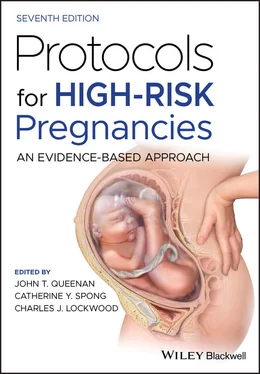Testing is generally initiated at 32–34 weeks for most patients; at 40 weeks for diet‐controlled gestational diabetics. However, it may begin as early as 26 weeks of gestation in pregnancies with multiple risk factors or when fetal compromise is suspected. The fetal heart rate reactivity may be diminished due to early gestational age and not necessarily reflect fetal compromise. Back‐up testing should be used whenever primary surveillance is of any concern.
Doppler velocimetry of the umbilical artery may be performed weekly in pregnancies complicated with suspected intrauterine growth restriction. This ultrasound procedure is generally performed in addition to biweekly nonstress testing.
A normal fetal surveillance heart rate test is typically repeated on a twice‐weekly basis.
Test should be immediately repeated in the event of significant deterioration in the clinical status regardless of the time elapsed since the last test. Intervention with delivery is always a clinical decision and may be indicated with either normal or abnormal testing depending upon the clinical circumstances.
1 American College of Obstetricians and Gynecologists. Antepartum Fetal Surveillance. Practice Bulletin Number 145. Obstet Gynecol 2014; 124:182–92.
2 Baschat AA, Gembruch U, Harman CR. The sequence of changes in Doppler and biophysical parameters as severe growth restriction worsens. Ultrasound Obstet Gynecol 2001; 18:571.
3 Burgess JL, Unal ER, Nietert PJ, Newman RB. Risk of late‐preterm stillbirth and neonatal morbidity for monochorionic and dichorionic twins. Am J Obstet Gynecol 2014; 210(6):578.
4 Evertson LR, Gauthier RJ, Schifrin BS, Paul RH. Antepartum fetal heart rate testing. I. Evolution of the nonstress test. Am J Obstet Gynecol 1979; 133:29.
5 Freeman RK, Anderson G, Dorchester W. A prospective multi‐institutional study of antepartum fetal heart rate monitoring. I. Risk of perinatal mortality and morbidity according to antepartum fetal heart rate test results. Am J Obstet Gynecol 1982; 143:771.
6 Lagrew DC, Pircin RA, Towers CV, Dorchester W, Freeman RK. Antepartum fetal surveillance in patients with diabetes: when to start? Am J Obstet Gynecol 1993; 168:1820.
7 Manning FA, Platt LW, Sipos L. Antepartum fetal evaluation: development of a biophysical profile. Am J Obstet Gynecol 1980; 136:787.
8 Miller DA, Rabello YA, Paul RH. The modified biophysical profile: antepartum testing in the 1990s. Am J Obstet Gynecol 1996; 174:812.
9 Nageotte MP, Towers CV, Asrat T, Freeman RK. Perinatal outcomes with the modified biophysical profile. Am J Obstet Gynecol 1994; 170:1672.
10 Signore C, Freeman RK, Spong CY. Antenatal testing – a reevaluation. Executive summary of the Eunice Kennedy Shriver National Institute of Child Health and Human Development Workshop. Obstet Gynecol 2009; 113:687.
11 Stillbirth Collaborative Research Network Writing Group. Association between stillbirth and risk factors known at pregnancy confirmation. JAMA 2011; 306(22):2469.
PROTOCOL 9 Fetal Blood Sampling and Transfusion
Patricia Santiago‐Munoz
Department of Obstetrics and Gynecology, Division of Maternal‐Fetal Medicine, University of Texas Medical Center, Dallas, TX, USA
Fetal blood sampling or cordocentesis is a straightforward procedure where fetal blood is typically accessed at the site of the umbilical vein, using a long, small‐gauge spinal needle. Access to fetal blood via the hepatic vein or heart (cardiocentesis) has also been described. Fetal blood sampling is performed for various indications such as cytogenetic diagnosis, congenital infection, and fetal anemia. It is rarely performed for the evaluation of fetal coagulopathies and platelet disorders, given the potential risk for fetal hemorrhage secondary to the pathologies suspected. Most of the time cordocentesis is performed as the precursor to fetal transfusion.
As earlier and earlier identification of fetal anomalies with ultrasound has become more common, most patients who choose invasive diagnostic testing typically rely on chorionic villus sampling or amniocentesis, which can yield earlier results than cordocentesis would. In addition, the advent of noninvasive prenatal testing (NIPT) has also decreased patient requests for invasive testing overall, especially in the setting of normal sonographic findings. Cytogenetic analysis via fetal blood sampling is usually reserved for cases where quick turnaround of results is required, such as when a patient is nearing the gestational age for legal termination of pregnancy or when the results might affect delivery planning and neonatal management of a fetus with an anatomical abnormality.
Cordocentesis is rarely used to evaluate or treat a fetus with congenital infection. Most diagnoses are suspected based on maternal serologies and ultrasound findings, and confirmed through polymerase chain reaction (PCR) in amniotic fluid. The one exception to this rule would be the evaluation and treatment of fetal parvovirus B19 infection, which causes fetal anemia via bone marrow failure.
Given current technologies and diagnostic tools, most cordocenteses are done in the evaluation of the fetus suspected to be anemic, the overwhelming majority typically due to maternal severe red blood cell alloimmunization. Fetuses at risk of anemia are identified by serial Doppler interrogation of the middle cerebral artery to measure peak systolic velocity. A distant second indication for cordocentesis is parvovirus B19 infection. The literature reports other potential indications for fetal transfusion, including fetomaternal hemorrhage, twin anemia polycythemia sequence, and alpha‐thalassemia, as well as placental and fetal tumors, but because these indications are so rare, none of them has sufficient data to show that fetal transfusion leads to improved outcomes.
Over the last 15 years, reported survival rates for intrauterine fetal transfusion for red cell alloimmunization have improved to over 90% in expert hands. Survival rates for parvovirus infection are lower, in the 70–80% range, likely related to late diagnosis in many cases. In the largest series to date of fetal intravascular transfusion, procedure‐related complications have decreased over time, from 9.8% to 3.3% per fetus. The two most common complications of fetal transfusion in this series were fetal demise and fetal distress leading to emergency cesarean delivery. Fetal distress may occur due to cord trauma or volume overload related to the procedure itself. Delayed complications include chorioamnionitis, premature rupture of membranes, and preterm labor but these are extremely rare. Needling of a free loop of cord, inadvertent arterial puncture, and failure to use fetal paralysis are all associated with higher rates of procedural complications. Nonetheless, procedure‐related fetal demise decreased over time in this large series of 1678 transfusions, from 1.6% to 0.6% per procedure. Associated risk factors for fetal loss include presence of fetal hydrops, early gestational age at first transfusion, and limited operator experience.
There is evidence to suggest long‐lasting effects of fetal anemia seen in survivors of fetal blood transfusion. Studies done in these patients and in their nonanemic siblings show that the subjects who underwent transfusion were born at earlier gestation, and as adults have smaller left ventricular volumes, increased left ventricular wall thickness, and decreased myocardial perfusion at rest. This is important information that shows that cardiovascular development is altered in fetuses who survive anemia, which may have implications for adult cardiovascular health. Reassuringly, neurodevelopmental outcomes appear to be good, and at least one large study of over 1284 fetal transfusions performed in 451 fetuses in a 20‐year period showed that over 95% of the survivors had normal neurodevelopment.
Читать дальше












